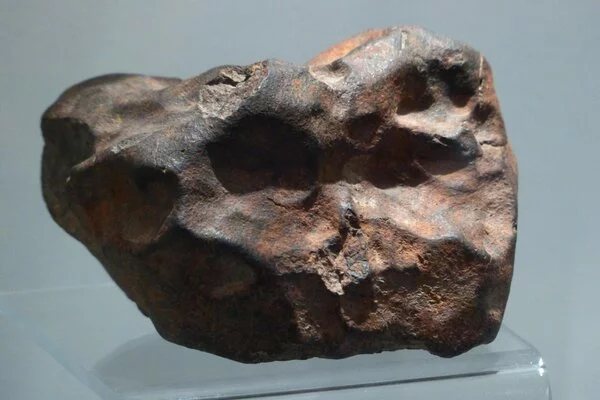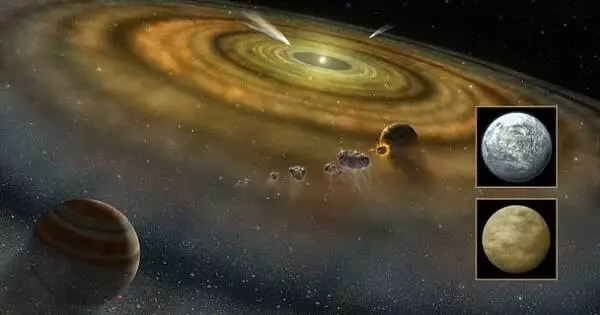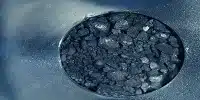A Martian meteorite is a rock that formed on Mars, was ejected from the planet by an impact event, and traveled through interplanetary space before landing on Earth as a meteorite. As of September 2020, 277 meteorites had been classified as Martian, representing less than half of the 72,000 meteorites classified. Taoudenni 002, the largest complete, uncut Martian meteorite, was recovered in Mali in early 2021. It weighs 14.5 kilograms (32 pounds) and is on display at the Maine Mineral & Gem Museum.
A new study of an old meteorite contradicts current thinking about how rocky planets like Earth and Mars acquire volatile elements like hydrogen, carbon, oxygen, nitrogen, and noble gases as they form. The findings have been published in Science.
According to Sandrine Péron, a postdoctoral scholar working with Professor Sujoy Mukhopadhyay in the Department of Earth and Planetary Sciences at the University of California, Davis, “a basic assumption about planet formation is that planets first collect these volatiles from the nebula around a young star.” Because the planet is a molten ball at this point, these elements dissolve into the magma ocean before degassing back into the atmosphere. More volatile materials are later delivered to the young planet by chondritic meteorites crashing into it.
The interior composition of krypton on Mars is nearly entirely chondritic, but the atmosphere is solar. It’s quite distinct. The findings indicate that Mars’ atmosphere could not have formed solely through mantle outgassing, as this would have given it a chondritic composition.
Sandrine Péron
As a result, scientists anticipate that the volatile elements in the planet’s interior will reflect the composition of the solar nebula, or a mixture of solar and meteoritic volatiles, while the volatiles in the atmosphere will primarily come from meteorites. The ratios of noble gas isotopes, particularly krypton, distinguish these two sources: solar vs. chondritic.
Mars is of particular interest because it formed relatively quickly, solidifying in about 4 million years after the birth of the Solar System, whereas the Earth took 50 to 100 million years. “We can reconstruct the history of volatile delivery in the first few million years of the Solar System,” Péron said.
Meteorite from Mars’ interior
Some meteorites that fall to Earth come from Mars. Most come from surface rocks that have been exposed to Mars’ atmosphere. The Chassigny meteorite, which fell to Earth in north-eastern France in 1815, is rare and unusual because it is thought to represent the interior of the planet.

The researchers were able to deduce the origin of elements in the rock by taking extremely precise measurements of minute amounts of krypton isotopes in meteorite samples using a new method developed at the UC Davis Noble Gas Laboratory. “Krypton isotopes are difficult to measure due to their low abundance,” Péron explained.
Surprisingly, the krypton isotopes in the meteorite match those found in chondritic meteorites rather than the solar nebula. That means that, in the presence of the nebula, meteorites were delivering volatile elements to the forming planet much earlier than previously thought, reversing conventional thinking.
“The interior composition of krypton on Mars is nearly entirely chondritic, but the atmosphere is solar,” Péron explained. “It’s quite distinct.”
The findings indicate that Mars’ atmosphere could not have formed solely through mantle outgassing, as this would have given it a chondritic composition. To prevent significant mixing between interior chondritic gases and atmospheric solar gases, the planet must have acquired atmosphere from the solar nebula after the magma ocean cooled.
According to the new findings, Mars’ growth was completed before the solar nebula was dissipated by radiation from the Sun. However, the irradiation should have also blown off Mars’ nebular atmosphere, implying that atmospheric krypton must have been preserved in some way, possibly trapped underground or in polar ice caps.
“However, that would imply that Mars was cold in the immediate aftermath of its accretion,” Mukhopadhyay explained. “While our research clearly demonstrates the presence of chondritic gases in the Martian interior, it also raises some intriguing questions about the origin and composition of Mars’ early atmosphere.”
Péron and Mukhopadhyay hope that their research will spark additional research on the subject. Péron is now a postdoctoral researcher at the ETH Zürich in Switzerland.















